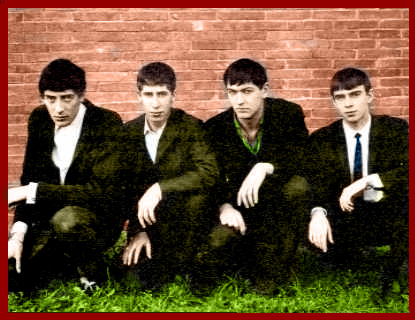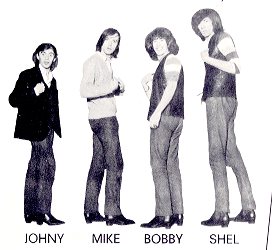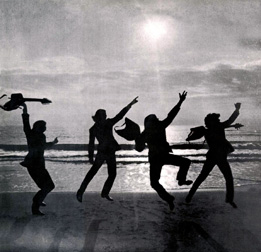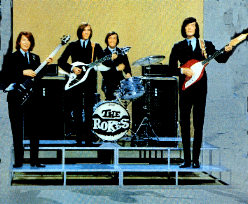(corrected and updated by Bobby Posner himself !)


In his early days as a musician, Norman David Shapiro, aka Shel, was recruited by Rob Storm & The Whispers and by other blues bands starting to play in the London venues. In 1959 Shel joins The Blue Caps, the famous band who backed up Gene Vincent. After that, Shel starts his first own band, The Shel Carson Combo, together with Vic Briggs on guitar, Mike Shepstone on drums, Bobby Posner on Bass. Starting with some parties for a few friends in London, they soon managed to play in the smoky pubs around Carnaby Street like the Roaring Twenties. Their initial set mainly consisted of standard blues songs, and they even performed with people such as Jeff Beck and Eric Clapton.
The Rokes officially start their career in London, as the 'Shel Carson Combo' but as many other beat bands after touring England they decide to travel up and down Europe to play in front of foreign audiences for more money. In January 1963 they went to Hamburg, Germany, where they had a residency at the Top Ten Club (The Beatles were just around the corner at the 'Star Club') In Germany they were highly appreciated, and it was there that they incidentally found their way to Italy, the country where they achieved popularity and success. Johnny Charlton on guitar, replaced Vic Briggs after their German tour. (Vic joined up with Dusty Springfield and later with Eric Burdon and The Animals). With Johnny in the new line up, The Shel Carson Combo came to Italy on the 8th of May 1963, where they accompany singer Colin Hicks, the younger brother of the famous english rocker Tommy Steele, whose Giddyup a ding dong was the soundtrack of the Italian movie "Europa di notte". They sign as backup band for Hicks but, according to the contract, they have to change their name to The Cabin Boys. They play in places like the Alcione theatre in Milano, earning success among the audience. Before a show in Torino, it happened that Colin Hicks got sick and completely lost his voice. So 'The Cabin Boys' who always opened the show just before Colin, replaced him, performing more of their songs, in the rhythm & blues vein, and leaving the stage in front of a gone wild audience. During their live show at the Ambra-Jovinelli in Rome, they were signed by Teddy Reno, the manager of the famous Italian girl singer Rita Pavone, to support her Italian tour. It's at this point that the guys decided they had to find another name, and The Rokes were born ! The name was chosen by Johnny on a night when he was completely drunk ! They started to make some television publicity spot for a famous ice cream brand named Algida and recorded their first 45 single Shake, rattle and roll, produced by Teddy Reno for the ARC label, an RCA subsidiary.
Extremely long hair, hi-heeled boots and, most of all, their 12-string electric guitar sound led them to take a residency at the famous Piper Club in Rome, where they gained a big success among the Italian teenagers. From now on the official press started to call them the Italian Beatles, or The rivals of The Beatles: they obtained more and more success with their singles, always reaching the high positions of the Italian charts, together with the Equipe 84, from 1965 until the late 1969, a great period for the Italian Beat music. The period which goes from 1964 to 1967 is their best: Ascolta nel vento, C'è una strana espressione nei tuoi occhi (cover of When you walk in the room by Jackie De Shannon), La mia città, Grazie a te (cover of I'm alive by The Hollies), Proprio niente from their second album, are songs with an incredible freshness and magic melodies. The 12 string guitar sound merges with Shel's voice and his englished Italian, while the other guys provide remarkable choruses. With Che colpa abbiamo noi single, which was the italian cover of Bob Lind's Cheryl's goin' home, The Rokes had their greatest hit: the song has some "protest" lyrics which perfectly fit in a nice melody for this folkbeat ballad. On its flip is Piangi con me, which was soon a hit for The Grassroots, an american group, with the english version Let's live for today. The Rokes recorded it in 1967 (see Discography) on a 45 very rare now.
The next single was another Bob Lind's successful song titled Remember the rain, and The Rokes made another successful single with more peaceful lyrics with E' la pioggia che va. Among the most resonable events The Rokes partecipated are to remember the Cantagiro '66 with Che colpa abbiamo noi, the Cantastampa '66 with Che mondo strano, the Sanremo Music Festival 1967 with Bisogna saper perdere, the International Show in Venezia with Ricordo quando ero bambino in 1967, and the Sanremo Festival 1968 with Le opere di Bartolomeo. Also they were broadcasted in TV shows as "Studio Uno", "Cordialmente", "Aria Condizionata" and even appeared in a couple of teen Italian movies like Rita la figlia americana, where they backed up Rita Pavone and the greatest Italian comic character Totò on the film; and another movie Altissima Pressione.
The Rokes also passed the flower power period, and they recorded songs such as Cercate di abbracciare tutto il mondo come noi, where even the record cover smelled of flowers ! While Finché c'è musica mi tengo su shows their psychedelic influences and features a sitar jangling throughout the whole song. In 1967 they record Eccola di nuovo, taken from the Cat Steven's original Here comes my life and another 45 with Bisogna saper perdere. In 1968 the Rokes sold about 3 million singles, but this is also the year of their decline, started with the release of Lascia l'ultimo ballo per me (the Drifter's Save the last dance for me) backed with Io vivrò senzate written by Mogol-Battisti on the B side. There's another song written by these composers titled Quando si alza il vento and translated When the wind arises for the Rokes, who recorded it in 1967 for the american release only; the Dik Dik and Lucio Battisti, the author of the song, recorded it for the Italian market. The Rokes arrangement gives a psychedelic touch to the song which is the rarest ever recorded by this versatile band. The same year they partecipate at the Sanremo Festival with Le opere di Bartolomeo, a pathetic tune below their usual standards and possibilities. In 1969 they are again at the Sanremo Festival withMa che freddo fa, but the band is evidently weary and lost its original creative inspiration. Their latest singles lost their original freshness which definitely cannot be compared to the early ones, they alternate their own songs with covers such as Se io fossi povero (from the LP Che mondo strano), originally If I were a carpenter written by Tim Hardin. Worth to remember are Non c'è pace per me, the italian version of Baby come back by the Equals, and Hello come stai from Hello how are you by the Easybeats.
The last 45 by the Rokes is Ombre blu with orchestral arrangements, in which Johnny Charlton didn't take part at the recording session, with Sempre giorno (parte 1) on the flip side. They recorded four albums from 1965 to 1968, the first of which , produced by Teddy Reno, has a black and opening cover and was recorded in January 1965, containing six songs sung in english. Volume 2° is one of their best recordings: the songs aren't on any of their singles, 9 of the 12 are in english (Take a look, Put the pendown and I would give the world). Che mondo strano, the third LP, shows the Rokes on the cover holding foreign newspaper cut-outs. It is mainly sung in Italian and among these are Baby Blue by Bob Dylan, Bambina sung by Mike Shepstone, Dall'altra parte written by Bardotti-Shapiro and featuring Johnny Charlton as lead singer. The last album from 1968, The Rokes, is their swan song but still contains good songs.The last concert they made was the 8th of August 1970 in front of 12000 people ! The decision to "call it quits" was suddenly taken, and cleverly anticipated a natural end which was bound to happen.



This information is from 1986 but it shouldn't be so much different now: Shel Shapiro, after two solo albums, became a producer for artists such as Mina, Patty Pravo, Gianni Morandi, Loredana Bertè and wrote many successful songs for them. He lives between Rome and Milano. In 1971 Johnny Charlton opened his own electronic lab, he lives in Rome, where he's the owner of an Art Gallery. Mike Shepstone formed his own band called PAX in 1971, but they lasted just seven months. Together with Bobby (Posner) they went back to England in June 1974. They are both married, Mike has one child and Bobby has two. Bobby Posneractually is the owner of a disco-pub in Hastings, Bobby is still active on the music scene and has been playing and singing for the last 14 years with a successful band called 'Grundy'. While Mike lives in Bournemouth and deals with antiques.